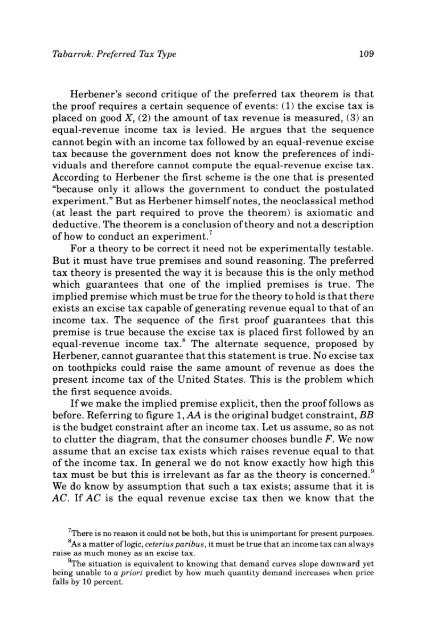Review of Austrian Economics - The Ludwig von Mises Institute
Review of Austrian Economics - The Ludwig von Mises Institute
Review of Austrian Economics - The Ludwig von Mises Institute
Create successful ePaper yourself
Turn your PDF publications into a flip-book with our unique Google optimized e-Paper software.
Tabarrok: Preferred Tax Type 109<br />
Herbener's second critique <strong>of</strong> the preferred tax theorem is that<br />
the pro<strong>of</strong> requires a certain sequence <strong>of</strong> events: (1) the excise tax is<br />
placed on good X, (2) the amount <strong>of</strong> tax revenue is measured, (3) an<br />
equal-revenue income tax is levied. He argues that the sequence<br />
cannot begin with an income tax followed by an equal-revenue excise<br />
tax because the government does not know the preferences <strong>of</strong> individuals<br />
and therefore cannot compute the equal-revenue excise tax.<br />
According to Herbener the first scheme is the one that is presented<br />
"because only it allows the government to conduct the postulated<br />
experiment." But as Herbener himself notes, the neoclassical method<br />
(at least the part required to prove the theorem) is axiomatic and<br />
deductive. <strong>The</strong> theorem is a conclusion <strong>of</strong> theory and not a description<br />
<strong>of</strong> how to conduct an experiment. 7<br />
For a theory to be correct it need not be experimentally testable.<br />
But it must have true premises and sound reasoning. <strong>The</strong> preferred<br />
tax theory is presented the way it is because this is the only method<br />
which guarantees that one <strong>of</strong> the implied premises is true. <strong>The</strong><br />
implied premise which must be true for the theory to hold is that there<br />
exists an excise tax capable <strong>of</strong> generating revenue equal to that <strong>of</strong> an<br />
income tax. <strong>The</strong> sequence <strong>of</strong> the first pro<strong>of</strong> guarantees that this<br />
premise is true because the excise tax is placed first followed by an<br />
equal-revenue income tax. 8 <strong>The</strong> alternate sequence, proposed by<br />
Herbener, cannot guarantee that this statement is true. No excise tax<br />
on toothpicks could raise the same amount <strong>of</strong> revenue as does the<br />
present income tax <strong>of</strong> the United States. This is the problem which<br />
the first sequence avoids.<br />
If we make the implied premise explicit, then the pro<strong>of</strong> follows as<br />
before. Referring to figure 1, AA is the original budget constraint, BB<br />
is the budget constraint after an income tax. Let us assume, so as not<br />
to clutter the diagram, that the consumer chooses bundle F. We now<br />
assume that an excise tax exists which raises revenue equal to that<br />
<strong>of</strong> the income tax. In general we do not know exactly how high this<br />
tax must be but this is irrelevant as far as the theory is concerned. 9<br />
We do know by assumption that such a tax exists; assume that it is<br />
AC. If AC is the equal revenue excise tax then we know that the<br />
7 <strong>The</strong>re is no reason it could not be both, but this is unimportant for present purposes.<br />
8 As a matter <strong>of</strong> logic, ceterius paribus, it must be true that an income tax can always<br />
raise as much money as an excise tax.<br />
<strong>The</strong> situation is equivalent to knowing that demand curves slope downward yet<br />
being unable to a priori predict by how much quantity demand increases when price<br />
falls by 10 percent.

















